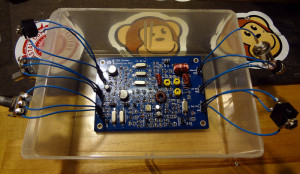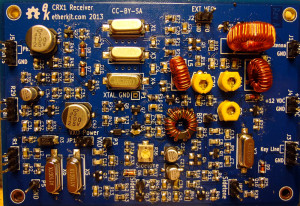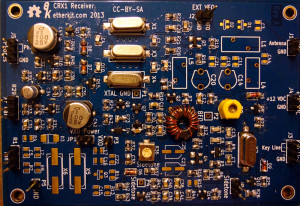Attached all the external bits to CRX1, connected the straight key, headphones and antenna, and then applied power.

No smoke, no flames, huzzah! It works!
Put on the head phones and immediately heard the same whining noise that the CC1 I assembled was making. There was also no sidetone when I pressed down the straight key.
Crap. Failing at building things.
Fortunately Jason/NT7S and Thomas/LA3PNA happened to be around in the #etherkit IRC channel (irc.recursiv.com), and helped me do some troubleshooting. Ran through some simple tests with Thomas to verify that at least the sidetone, audio and muting sections were working. Added a jumper to JP2, which gave me a sidetone. Had I read the assembly docs closer, I’d have known that.
Jason provides voltages to look for on the transistors, so out came the DVM and I started poking around. Everything checked out ok, except I wasn’t getting voltage readings in the VXO section. Duh, I needed to add a jumper to JP1, which I also would have known had I read the assembly docs closer.
Once I did that and applied power again, I started hearing some noise and also caught a small bit of CW in the background. Success! The whine was still there though.
Jason suggested the wall wart as the source of the whine. Apparently wall warts are notorious for being noisy like that. I’ll need to make up a connector so I can use a battery or the radio power supply. Hopefully that will do the trick. Then I can go through the alignment process.
You know, this plastic parts bin could actually make kind of a neat container for CRX1. Punch a few holes for all the connectors/pots, and add some feet. That could work, right?
The wall wart is probably why the CC1 produced the same whine as well. I guess I’ll have to clear some space on the bench for that big old Astron power supply.
Maybe I really can build things after all.

